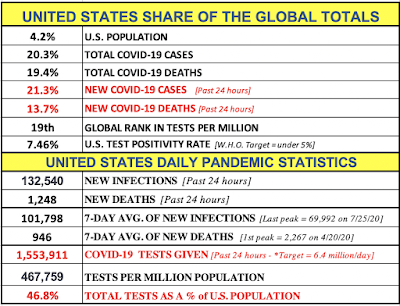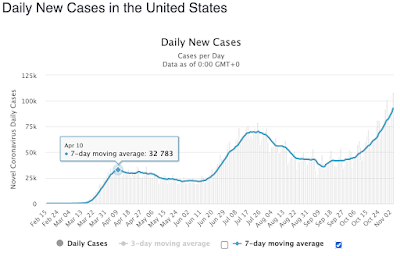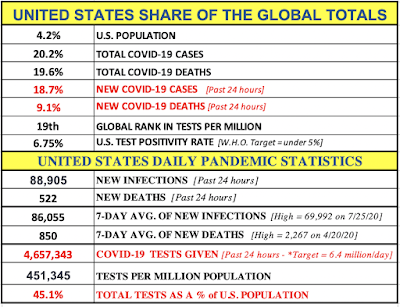by Brian T. Lynch, MSW
Welcome to the Daily Pandemic Diary for November 2020. The purpose here is to provide a global context to how our nation is coping with the pandemic and to supply information about COVID-19 that might be helpful to the readers. This blog continues the daily collection of data begun in the Daily Update blog and the monthly Daily Pandemic Diaries linked below. The raw data comes from the independent, international non-profit data reporting organization called Worldometer.info. Test Positivity data comes from Johns Hopkins University. Data in red are calculated values.
- We started the month first in the amount of community spread and added to that lead all month long.
- We started with 86,293 infections in a day and (despite a significant undercount) ended with 138,096 new cases yesterday.
- That's more than 2.5 times India's daily new cases.
- Our global share of total COVID cases rose from 20.3% on November 1st. to 21.8% today, yet our global share of COVID deaths continued to decline from 19.7% to 18.6% - due in large part because of a systematic undercount of COVID deaths in the United States [See days 234, 238, 239 below].
- The spread of new infections more than doubled from the beginning of the month.
- While fewer new deaths were recorded yesterday than on November 1st. (again because of unreported deaths) the 7-day average number of deaths per day rose by 73%.
- 37,005 people died of COVID-19 this month
- 4.35 million people were infected with COVID-19 in November.
- We have 13.7 million total coronavirus cases
- We have 273,077 deaths this month.
"Fewer than half the states are following federal recommendations to report probable novel coronavirus cases and deaths, marking what experts say is an unusual break with public health practices that leads to inconsistent data collection and undercounts of the disease’s impact."
Here is an example of a probable COVID-19 case based on CDC criteria: The wife of a man with a laboratory-confirmed case of COVID-19 come down with symptoms of the virus herself. She tests positive on a rapid antigen test and her doctor diagnoses her as having COVID-19 based on her exposure to her husband, the symptoms she is experiencing, and the rapid test results. Under the CDC guidelines, this doctor is expected to report her as a probable coronavirus case. Why probable? Because she wasn't given the most definitive PCR lab test. There is little clinical doubt that this woman has the virus, but it isn't being reported in over 24 states, according to the Washington Post investigation. And if she died, and no PCR test was performed, her death may or may not be recorded as a COVID-19 death. Also from the WP article:
The failure of many states to document probable coronavirus cases and deaths is “historic in many ways because there are lots of probable case classifications and probables are regularly and normally reported on,” said Janet Hamilton, the CSTE executive director. “We are definitely concerned about the undercounting of covid-19 deaths and cases.”

- GOOD QUALITY MASKS (PROPERLY WORN),
- SOCIAL DISTANCING,
- HAND WASHING,
- RESTRICTED TRAVEL,
- SMALL SOCIAL GATHERINGS,
- GOOD VENTILATION,
- SELF-QUARENTINING IF YOU FEEL ILL or TEST POSITIVE
Comments: There was more positive news about vaccine development today. A general undercount of COVID deaths throughout the pandemic is well documented, but there is a growing number of states not reporting any deaths data on a daily basis. Given that these reports may not be generated from state administration officials directly, the cause of these omissions is a mystery.
"Dr. Michael Mina is a Harvard Epidemiologist says we can beat COVID-19 with the widespread and frequent use of cheap, at-home screening tests. Please hear him out and if you agree, speak out on social media and write to your representatives and the new administration to demand a better testing program that includes nationwide in-home screening tests.
How likely is it you’ll encounter at least one person who is infected with the coronavirus if you go to a bar in Denver? What about a 100-person wedding in Baltimore? Or a Thanksgiving dinner with 25 guests in Los Angeles? - (And if you’re curious, as of Monday, you’d have a 78% chance of encountering someone with an active coronavirus infection at the Denver bar, a 68% chance at the wedding in Baltimore, and a roughly 25% chance at the L.A. Thanksgiving meal.)

The vaccine... consists of molecular instructions — in the form of messenger RNA (mRNA) — for human cells to make the coronavirus’ spike protein, the immune systems’ key target for coronaviruses. The two-dose vaccine showed promise in animal studies and early-stage clinical trials. But the only way to know if the vaccine works is to give it to large numbers of people, and then follow them over weeks or months to see if they become infected and show disease symptoms.
UNDERCOUNT: Today's data is missing the number of new cases and deaths from Michigan, Nebraska, Rhode Island, Oklahoma, and Connecticut. Also missing are new death reports from New Hampshire, Alaska, Maine, West Virginia, and D.C. International data is also missing from Spain (over 20,000 new cases per day), Sweden, and Switzerland.
Comments: The U.S. had the highest number of daily new infections in the history of this pandemic yesterday, higher than the next three worst countries combined. The tsunami is upon us and still building. Texas had over 10,000 new cases yesterday. Illinois had over 7,500 new cases. Only now, as we face the prospect of 200,000 new infections per day in December, does Dr. Robert Redfield of the CDC raise the need for a national testing strategy... in a tweet:
US Centers for Disease Control and Prevention (CDC) Director Dr. Robert Redfield tweeted on Wednesday, “Now is the time to develop a testing strategy to maximize our ability to identify the silent epidemic of asymptomatic COVID-19 infections.”
Here is what this 7-day moving average of new cases looks like in this third surge so far:
New Jersey was one of the hardest-hit states back in March. It is the state with the most deaths per million. It now has a 7-day average for new cases at levels not seen since mid-May, yet gyms, bars, and restaurants remain open and people are congregating unsafely as if the crisis has passed. Starting tomorrow, New Jersey will be the first state to mandate safety protocols to protect workers from the coronavirus, including mandating temperature checks when they come to work, and more frequent breaks to wash their hands during the day. What is wrong with business owners that such common-sense measures would have to be mandated in the first place? There wouldn't be these "onerous, new regulations" (as our Republican leaders call them) if everyone did the sensible thing. How long can a business operate if they don't protect their workforce from the pandemic? We are seeing irrational, politically motivated resistance to common sense precaution in every state. We need to ask ourselves why politics has become such a massive influence on our daily lives.
Comments: With a national election still underway amidst a coup attempt to stop the vote count... the COVID-19 virus continues to spread unrestrained but not unnoticed. The U.S. had far more reported new cases yesterday than did India and France combined. The 7-day average continues its climb, having doubled in just 30 days. This is in line with the projections, which also suggest the numbers will double again by year-end if we don't adopt universal mask use. By tomorrow there will be a 7-day average of over 20,000 more people catching the virus per day than during the July peak. With all states but Alaska reporting on deaths, the total is nearly 1,200 dead. This is still an undercount. A statistically realistic total would be more like 1,550.
Comments: With a weekly average of almost 83,000 new infections per day, the U.S. remains #1 in the spread of the virus. Today's numbers are undercounted as four states (MI, KS, CT, and NE) have not reported any data over the weekend. Additionally, the death count is significantly undercounted as another six states (DC, NH, WV, WY, WA, and TN) have not submitted that data.




































































No comments:
Post a Comment
Please feel free to comment or make suggestions